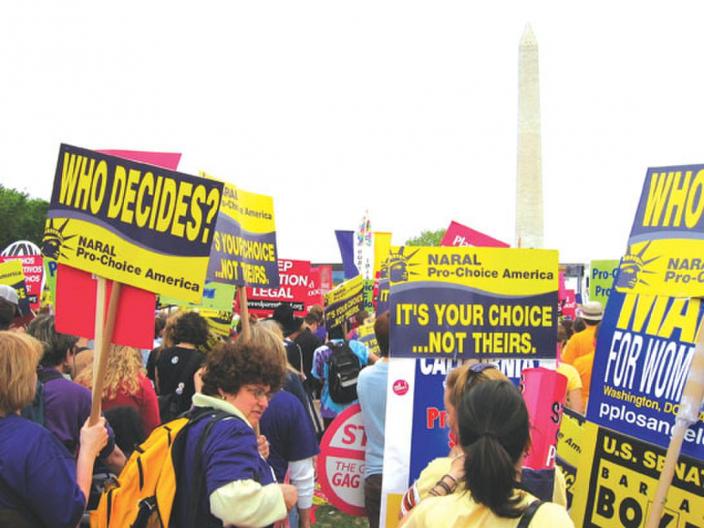
Forty-five years have passed since the Supreme Court decision in Roe v. Wade affirmed a woman’s right to make her own choices about her body and her health. Yet this groundbreaking decision is now facing more threats than ever. In fact, while the right to an abortion is still the law of the land, abortion is available to fewer and fewer women.
We have all read news reports of assaults and harassment of abortion patients and clinic employees. More insidious are legislative efforts to restrict access to abortion through TRAP (Targeted Regulation of Abortion Providers) laws. These laws impose unfounded and excessive requirements on facilities, hospital admitting privileges, and procedure room size or corridor width. Other laws mandate waiting periods or parental or spousal consent.
Assaults on the right to an abortion at the state level have skyrocketed in the last six years. 334 abortion-restrictive laws have been enacted by states since 2011—thirty percent of all the abortion restrictions enacted by states since the Roe decision 45 years ago. The Guttmacher Institute reports that 63 state abortion restrictions were enacted in 2017 alone. Many of these restrictions are scientifically unfounded.
What has been the effect of these laws? Women are deprived of information they need to make an informed decision about their pregnancy options; the number of abortion service providers has declined; women have to travel farther to obtain abortion services; abortions are delayed. How ironic is it then, that today support for legal abortion is at a 20-year high with 7 in 10 Americans opposing overturning Roe.
Many women today do not remember a time before Roe. Our grandmothers, however, do. And there are many anecdotal, historical accounts of what abortions were like before they were legalized in 1973.
In 1928, Margaret Sanger, who opened the first birth control clinic in the United States in Brooklyn, published Motherhood in Bondage, a selection of 470 of the 250,000 letters she had received from women (and some men) asking for advice on birth control. These letters give insight into early 20th Century family life, when there was no access to reliable contraception and abortions were ubiquitous. In her Foreword to the 2000 edition, Margaret Marsh lists the methods available to women in the 1920’s who wished to terminate their pregnancies, including “orange sticks, slippery elm, and rubber catheters” and “knitting needles, crochet hooks, hairpins, scissors, and button hooks”.
Today abortion rates in the U.S. are at an all-time low due to better contraception and fewer unintended pregnancies - even lower than before 1973 and the legalization of abortion. And for women today who wish to terminate their pregnancies at home, there are other, safer methods available, such as the abortion pill which in the U.S. requires a prescription.
What would be the effect of restricted access to abortion if Roe is overturned? In the absence of Roe, abortion would remain legal in some states. 2017 saw an upsurge in abortion rights in 5 states. And in anticipation of the possibility that Roe could be overturned, some legislatures have or are passing laws that will ensure abortion remains legal in their states. However, women who do not live in such states, especially poor and underprivileged women, will surely seek other solutions. It is not hard to predict that illegal, non-medically supervised abortions would rise in the absence of Roe.
In fact, that may already be happening in some parts of the country. In The Return of the D.I.Y. Abortion, the New York Times reported that 2016 Google search data showed an increase in searches for phrases such as “how to have a miscarriage”, “how to self-abort”, “buy abortion pills online”, “free abortion pills”; in The Rise of the DIY Abortion, Glamour reported that more and more women are resorting to do-it-yourself abortions: herbs, supplements, self-injury and un-prescribed and therefore illegal abortion pills.
We have come a long way since 1973—the internet has the reach and potential to help women wherever they live to obtain counseling and information; and less intrusive and safer medical options have been developed to terminate a pregnancy. Hopefully, the DIY methods used by women before 1973 will remain permanently in the past. DIY is not a substitute for the treatment and services offered by a reproductive health clinic or medical professional.
Today, Roe v. Wade remains the law of the land. As we celebrate its 45th anniversary, I hope we redouble our commitment to protecting a woman’s right to make her own choices about her body, including her right to a safe, affordable, and legal abortion.
Julia Weinstein is the Women of Reform Judaism Vice President of Advocacy and Marketing & Communication and a member of University Synagogue, Los Angeles, CA.
This blog originally appeared on The RAC's blog.
Related Posts

Continuing to Educate and Empower People Together

My Challah-Making Experience


